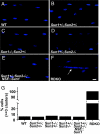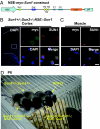SUN1 and SUN2 play critical but partially redundant roles in anchoring nuclei in skeletal muscle cells in mice
- PMID: 19509342
- PMCID: PMC2700906
- DOI: 10.1073/pnas.0812037106
SUN1 and SUN2 play critical but partially redundant roles in anchoring nuclei in skeletal muscle cells in mice
Abstract
How the nuclei in mammalian skeletal muscle fibers properly position themselves relative to the cell body is an interesting and important cell biology question. In the syncytial skeletal muscle cells, more than 100 nuclei are evenly distributed at the periphery of each cell, with 3-8 nuclei anchored beneath the neuromuscular junction (NMJ). Our previous studies revealed that the KASH domain-containing Syne-1/Nesprin-1 protein plays an essential role in anchoring both synaptic and nonsynaptic myonuclei in mice. SUN domain-containing proteins (SUN proteins) have been shown to interact with KASH domain-containing proteins (KASH proteins) at the nuclear envelope (NE), but their roles in nuclear positioning in mice are unknown. Here we show that the synaptic nuclear anchorage is partially perturbed in Sun1, but not in Sun2, knockout mice. Disruption of 3 or all 4 Sun1/2 wild-type alleles revealed a gene dosage effect on synaptic nuclear anchorage. The organization of nonsynaptic nuclei is disrupted in Sun1/2 double-knockout (DKO) mice as well. We further show that the localization of Syne-1 to the NE of muscle cells is disrupted in Sun1/2 DKO mice. These results clearly indicate that SUN1 and SUN2 function critically in skeletal muscle cells for Syne-1 localization at the NE, which is essential for proper myonuclear positioning.
Conflict of interest statement
The authors declare no conflict of interest.
Figures





Similar articles
-
KASH protein Syne-2/Nesprin-2 and SUN proteins SUN1/2 mediate nuclear migration during mammalian retinal development.Hum Mol Genet. 2011 Mar 15;20(6):1061-73. doi: 10.1093/hmg/ddq549. Epub 2010 Dec 21. Hum Mol Genet. 2011. PMID: 21177258 Free PMC article.
-
Syne-1 and Syne-2 play crucial roles in myonuclear anchorage and motor neuron innervation.Development. 2007 Mar;134(5):901-8. doi: 10.1242/dev.02783. Epub 2007 Jan 31. Development. 2007. PMID: 17267447
-
Mammalian SUN protein interaction networks at the inner nuclear membrane and their role in laminopathy disease processes.J Biol Chem. 2010 Jan 29;285(5):3487-98. doi: 10.1074/jbc.M109.071910. Epub 2009 Nov 21. J Biol Chem. 2010. PMID: 19933576 Free PMC article.
-
Interactions between nuclei and the cytoskeleton are mediated by SUN-KASH nuclear-envelope bridges.Annu Rev Cell Dev Biol. 2010;26:421-44. doi: 10.1146/annurev-cellbio-100109-104037. Annu Rev Cell Dev Biol. 2010. PMID: 20507227 Free PMC article. Review.
-
A nuclear-envelope bridge positions nuclei and moves chromosomes.J Cell Sci. 2009 Mar 1;122(Pt 5):577-86. doi: 10.1242/jcs.037622. J Cell Sci. 2009. PMID: 19225124 Free PMC article. Review.
Cited by
-
The diverse functional LINCs of the nuclear envelope to the cytoskeleton and chromatin.Chromosoma. 2013 Oct;122(5):415-29. doi: 10.1007/s00412-013-0417-x. Epub 2013 Jun 5. Chromosoma. 2013. PMID: 23736899 Free PMC article. Review.
-
LINC complexes form by binding of three KASH peptides to domain interfaces of trimeric SUN proteins.Cell. 2012 May 25;149(5):1035-47. doi: 10.1016/j.cell.2012.03.046. Cell. 2012. PMID: 22632968 Free PMC article.
-
rAAV-related therapy fully rescues myonuclear and myofilament function in X-linked myotubular myopathy.Acta Neuropathol Commun. 2020 Oct 19;8(1):167. doi: 10.1186/s40478-020-01048-8. Acta Neuropathol Commun. 2020. PMID: 33076971 Free PMC article.
-
How plants LINC the SUN to KASH.Nucleus. 2013 May-Jun;4(3):206-15. doi: 10.4161/nucl.24088. Epub 2013 May 13. Nucleus. 2013. PMID: 23680964 Free PMC article. Review.
-
A conserved KASH domain protein associates with telomeres, SUN1, and dynactin during mammalian meiosis.J Cell Biol. 2012 Jul 23;198(2):165-72. doi: 10.1083/jcb.201204085. J Cell Biol. 2012. PMID: 22826121 Free PMC article.
References
-
- Sanes JR, Lichtman JW. Induction, assembly, maturation and maintenance of a postsynaptic apparatus. Nat Rev Neurosci. 2001;2:791–805. - PubMed
-
- Starr DA, Fischer JA. KASH 'n karry: The KASH domain family of cargo-specific cytoskeletal adaptor proteins. Bioessays. 2005;27:1136–1146. - PubMed
-
- Tzur YB, Wilson KL, Gruenbaum Y. SUN-domain proteins: “Velcro” that links the nucleoskeleton to the cytoskeleton. Nat Rev Mol Cell Biol. 2006;7:782–788. - PubMed
-
- Wilhelmsen K, Ketema M, Truong H, Sonnenberg A. KASH-domain proteins in nuclear migration, anchorage and other processes. J Cell Sci. 2006;119(Pt 24):5021–5029. - PubMed
Publication types
MeSH terms
Substances
LinkOut - more resources
Full Text Sources
Other Literature Sources
Molecular Biology Databases
Research Materials
Miscellaneous

